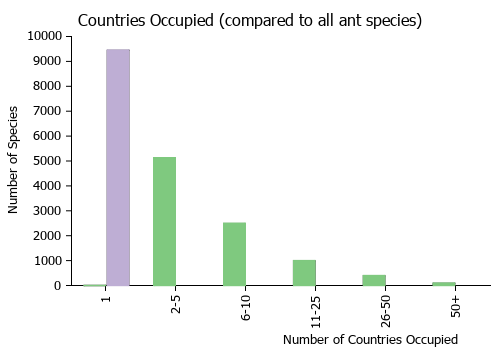Strumigenys moera
| Strumigenys moera | |
|---|---|
| Scientific classification | |
| Kingdom: | Animalia |
| Phylum: | Arthropoda |
| Class: | Insecta |
| Order: | Hymenoptera |
| Family: | Formicidae |
| Subfamily: | Myrmicinae |
| Tribe: | Attini |
| Genus: | Strumigenys |
| Species: | S. moera |
| Binomial name | |
| Strumigenys moera Bolton, 2000 | |
Nothing is known about the biology of Strumigenys moera.
Identification
Bolton (2000) - A member of the Strumigenys emeryi-group. Similar to Strumigenys sevesta but with narrower head, longer scape, better developed spongiform tissue ventrally on the petiole, a more extensive shining area on the pleurae and entirely reticulate-punctate pronotum.
Keys including this Species
Distribution
Latitudinal Distribution Pattern
Latitudinal Range: -0.2589° to -0.2589°.
| North Temperate |
North Subtropical |
Tropical | South Subtropical |
South Temperate |
- Source: AntMaps
Distribution based on Regional Taxon Lists
Neotropical Region: Ecuador (type locality).
Distribution based on AntMaps
Distribution based on AntWeb specimens
Check data from AntWeb
Countries Occupied
| Number of countries occupied by this species based on AntWiki Regional Taxon Lists. In general, fewer countries occupied indicates a narrower range, while more countries indicates a more widespread species. |

|
Estimated Abundance
| Relative abundance based on number of AntMaps records per species (this species within the purple bar). Fewer records (to the left) indicates a less abundant/encountered species while more records (to the right) indicates more abundant/encountered species. |

|
Biology
|
Castes
Nomenclature
The following information is derived from Barry Bolton's Online Catalogue of the Ants of the World.
- moera. Strumigenys moera Bolton, 2000: 516 (w.) ECUADOR.
Unless otherwise noted the text for the remainder of this section is reported from the publication that includes the original description.
Description
Worker
Holotype. TL 2.9, HL 0.73, HW 0.52, CI 71, ML 0.42, MI 57, SL 0.52, SI 100, PW 0.32, AL 0.72. Mandible without trace of preapical dentition. Apicoscrobal hair and pronotal humeral hair flagellate. Both pairs of erect hairs on cephalic dorsum stiff and simple; mesonotum with a similar but more acutely pointed pair of hairs (adherent to surface in holotype, most probably erect in life). Petiole, postpetiole and first gastral tergite with stiff simple hairs that are erect or inclined, shallowly curved along their length and mostly acute apically; those toward apex of first gastral tergite weakly flagellate. Pronotal dorsum reticulate-punctate, without superimposed rugular sculpture. Mesopleuron and most of metapleuron smooth and shining, side of propodeum reticulate-punctate. Propodeum with a pair of narrowly triangular acute spines, each subtended by a very narrow lamella, little more than a carina, down the declivity; propodeal lacuna absent. Ventral surface of petiole with a thin spongiform strip that commences at about the level of the spiracle and extends to the posteroventral angle, becoming deeper posteriorly. In profile ventral spongiform lobe of postpetiole small, slightly smaller than the area of exposed cuticle of the disc. Disc of postpetiole finely reticulate-punctate everywhere. Basigastral costulae sparse and very short, much shorter than postpetiole disc.
Type Material
Holotype worker, Ecuador: Provo Pichincho, 4 km. E Santo Domingo de los Colorados, 520 m., 22.vi.1975, B-304 (S. & J. Peck) (Museum of Comparative Zoology).
References
- Bolton, B. 2000. The ant tribe Dacetini. Memoirs of the American Entomological Institute. 65:1-1028. (page 516, worker described)
References based on Global Ant Biodiversity Informatics
- Fernández, F. and S. Sendoya. 2004. Lista de las hormigas neotropicales. Biota Colombiana Volume 5, Number 1.